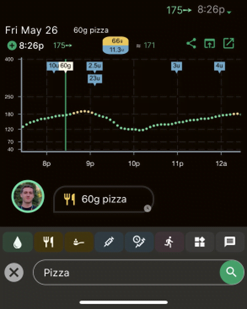While it’s crucial for children with type 1 diabetes to eat a balanced diet, some foods may make managing their blood sugar levels more difficult. That’s why the first line of diabetes therapy is usually making healthier food choices. That being said, everyone has a different opinion about the “proper diet” for a T1D – and that’s OK!
When you log all of your meals in Gluroo, you can quickly see which food types are easy to manage, and which are much more difficult. For example, you may find that your child always gets high blood sugar after eating pizza or sushi – two common foods that can be quite difficult to manage. While you don’t need to eliminate it from their diet, you may feel more empowered to reduce how often you eat pizza, and make it more of a special occasion.

With Gluroo, you don’t have to take our word for it. Simply logging your meals will make the optimal diet more clear to you.
If you’re new to T1D and are wondering which foods might be better to restrict in your child’s diet, here are some of our general suggestions and guidelines.
General Dietary Guidelines
General dietary recommendations for children with type 1 diabetes include:
- Balanced Meals: Children should aim for balanced meals that combine a variety of carbohydrates, proteins, and healthy fats. Promote the consumption of a wide range of nutrient-dense foods from all food groups. This contributes to longer-lasting energy and improved blood sugar regulation.
- Portion Control: Manage your child’s calorie intake and avoid erratic blood sugar levels by controlling meal sizes. It’s vital to keep an eye on portion sizes and modify them as necessary.
- Regular Mealtimes: To control blood sugar levels and maintain steady energy levels, establish regular mealtimes, and encourage your child to eat at regular intervals throughout the day.
- Hydration: Make sure your child drinks water throughout the day, to stay hydrated.
8 Foods to Avoid
Just as important as knowing which foods to include in a diabetes diet is understanding which ones to avoid. This is because a lot of foods and drinks are heavy in added sugar and carbohydrates, which raise blood sugar levels.
Although this is totally up to you, it’s usually recommended that children with diabetes avoid, or eat less of the following foods.
- Refined Grains: Refined grains like white bread, rice, and pasta are high in carbohydrates but low in fibre, so blood sugar levels may rise more quickly than with whole grains.
- High Glycemic Index Food: One method of managing diabetes with dietary changes is to maintain a balance between high and low GI foods. Compared to low GI foods, high GI foods raise blood sugar levels more. To help your body process high GI foods more slowly and make you feel fuller for longer, limit your consumption and pair them with sources of protein or healthy fat. The foods high in GI are white bread, puffed rice, white rice, white pasta, and white potatoes, pumpkin, melons, and pineapple.
- Refined Sugar: People with diabetes should limit or stay away from foods that contain refined sugar, such as homemade or store-bought cookies, cakes, and candies.
- Breakfast Cereal: Breakfast cereal can be a quick and easy breakfast option, but they might not be the best option for children with type 1 diabetes. They have a high carbohydrate content, added sugar, and a lack of fibre, all of which can cause a faster rise in blood sugar.
- Saturated Fats and Trans Fats: Saturated and trans fats are unhealthy fats that can exacerbate diabetic symptoms. These fats can be found in fried and processed foods including chips, pizza, baked goods, and fries. High fat content combined with high carbohydrate content makes for a very difficult meal.
- Sodium-Rich Foods: A high salt diet can elevate blood pressure and increase the risk of heart disease, both of which are a concern for people with diabetes. Steer clear of canned soups, processed foods, and salty snacks.
- Fried Foods: Foods that have been deep-fried in oils are high in trans fats and may cause insulin resistance. Limit your child’s intake of fried foods including fried chicken, fries, onion rings, and other deep-fried foods.
- Sweetened Drinks: Drinks high in sugar can interfere with your child’s insulin levels and lead to an imbalance. Examples include various coffees, smoothies, energy drinks, and of course, sodas.
Substitutions and Alternatives
Giving up on anything is not a solution because there are alternatives or substitutes for everything, even food. It’s crucial to make informed food choices and consider swaps and alternatives to your child’s favourite foods that can keep blood sugar levels constant.
Consider the following as alternatives:
- Whole Grains: Whole grains including whole wheat, quinoa, brown rice, and oats. These should be consumed instead of refined grains. These choices have a higher fibre content, which slows down digestion and helps keep blood sugar levels stable.
- Low-Sugar Foods: Choose healthier options like fresh fruits, raw veggies with hummus or Greek yoghurt dip, unsalted almonds, seeds, or low-sugar protein bars instead of sugary snacks.
- Low Glycaemic Index Food: It’s crucial to consider foods with a low glycemic index (GI). Foods with a low GI take longer to digest and absorb, which causes blood sugar levels to gradually rise. The following list of low-GI foods may be helpful for children with type 1 diabetes: Excellent options include bell peppers, zucchini, spinach, cauliflower, kale, citrus fruit, blueberries, raspberries, blackberries, etc.
- Sugar Alternatives: To sweeten foods and beverages, substitute artificial sweeteners or natural sweeteners like stevia or monk fruit for normal sugar. These alternatives may offer sweetness without raising or lowering blood sugar levels.
- Healthy Fats: Your meals should contain sources of healthy fats including avocados, nuts, seeds, and olive oil. These fats can facilitate digestion and offer long-lasting energy.
- Dairy Alternatives: There are a lot of dairy substitutes that can still deliver crucial nutrients without having a high saturated fat content. Low-fat dairy, unsweetened plant-based milk, skim milk, cottage cheese, dairy-free cheese, etc.
- Low-Sodium Options: Including low-sodium foods in your child’s diet will them control their blood sugar. Here are some low-sodium options to consider:
- Fresh fruits and vegetables: Put an emphasis on including a range of colourful foods in your child’s meals and snacks.
- Lean protein: Choose lean protein sources, such as fish, beans, lentils, tofu, skinless fowl, and low-fat dairy items.
- Fresh Herbs and Spices: Instead of using salt to season food and enhance flavours, use fresh herbs and spices. Try out ingredients like turmeric, cinnamon, ginger, parsley, cilantro, basil, and dill.
- Low-Sodium Condiments: Opt for low-sodium versions of condiments like ketchup, mustard, soy sauce, and salad dressings that have little to no added salt. As an alternative, reduce the salt content by making your own condiments using fresh ingredients.
- Canned Products with Reduced Sodium or No Salt Added: When using canned goods, choose the ones with reduced sodium or no salt added. To lower sodium content, properly rinse canned items before using.
If you’re wondering how to put these nutrition tips into practice, here are some ideas for kid-friendly as well as diabetes-friendly snacks, beverages, and meals.
Snack Ideas
- Veggie sticks (carrots, celery, bell peppers) with hummus or Greek yogurt dip.
- Hard-boiled eggs.
- Homemade protein bars
- Sugar-free egg muffin
- Air-popped popcorn (lightly seasoned).
- Whole grain crackers like Wasa
Meal Ideas
- Grilled or baked chicken breast or tofu with steamed vegetables
- Vegetable omelette with whole grain toast
- Whole grain pancakes
- Avocado chicken lettuce wraps
- Whole grain pasta in tomato sauce
- Zucchini noodles with marinara sauce and lean ground meat
- Lentil or bean soup
Beverages Ideas
- Water with lemon or lime juice
- Unsweetened iced tea
- Almond milk with no added sugar or low-fat milk
- Flavoured sparkling water with no sugar
- Vegetable juice
- Fruit-infused homemade water
You can check out our diabetes-friendly party food recipes for some more meal inspiration, if you’d like.
Additional Dietary Considerations
Beyond food choices, there are other aspects to consider when managing a child’s diabetes.
- Looking at Food Labels
It’s essential to read food labels to spot hidden sugars in packaged food. Numerous ingredients, including fructose, sucrose, corn syrup, and maltose can be used to disguise sugar. You can make educated decisions by looking for these ingredients and paying attention to the total amount of carbohydrates. When evaluating food labels, it’s also critical to consider serving sizes and the overall carbohydrate count per serving.
- Foods Glycemic Index (GI)
The glycemic index measures how quickly a food’s carbohydrates boost blood sugar levels. By being aware of food GIs, you can use this information to plan meals and snacks that will have a more regulated effect on your child’s blood sugar levels.
- Physical Activity
Along with a balanced diet, physical activity should be incorporated into diabetes care. Physical activity can raise or drop glucose levels based on factors like intensity and duration, so it’s crucial to check blood sugar levels before, during, and after. To establish the proper modifications to insulin or carbohydrate consumption before and after exercise, you should consult with your child’s medical team. Regular and consistent exercise results in regular and consistent insulin sensitivity, which will make managing diabetes a whole lot easier.
- Stress and Emotional Well-Being
Blood sugar levels in diabetic children can be affected by stress and emotions. Children’s bodies may release stress hormones that might cause blood sugar levels to rise when they are under stress, such as during exams or in social situations. It’s a good idea to do your best to stay aware of their child’s emotional wellbeing, offer support, and promote healthy ways to cope.
Gluroo Can Help Keep Your Child’s Nutrition in Check
The management of type 1 diabetes in children is greatly aided by a balanced, diabetes-aware diet.
It can be challenging to figure out which foods to forgo when your child has type 1 diabetes. However, if you follow a few guidelines, it can become simple.
While no food is strictly forbidden, foods with added sugar, sodium, saturated fat, and trans fats should be avoided or, if consumed, the frequency and portion sizes should be controlled. Also, encourage your child to choose water as a beverage of choice. If you need to, work with a nutritionist to establish the best diet plan for your child.
To see how different types of foods affect your child’s glycemic control, log their meals with Gluroo. Over time, you’ll build up a valuable database of meals, where you can then tap to see a chart of their BGL over the next few hours. Using that information can help you make informed decisions about which foods work and which foods don’t.
Download Gluroo for free today on Android and iOS.




